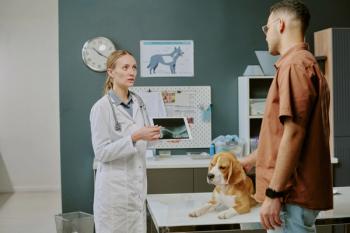
Building a disruptor in the reference lab space
How Zoetis Reference Laboratories streamlines diagnostic services
Historically, veterinary professionals have not had many options when working with reference laboratories. Zoetis Reference Laboratories (ZRL) seeks to shake up the market by offering unique benefits that differentiate it from the long-time entrenched players. Prior to launching ZRL, Zoetis already had been well-established in point-of-care diagnostics with its line of VETSCAN analyzers, as well as glucose and anesthesia monitoring systems. Over the past three years, the company built out its diagnostic offerings by acquiring and uniting three regional laboratories into a single, seamless, national laboratory.
In the latest episode of Pet Connections, dvm360’s Chief Veterinary Office Adam Christman, DVM, MBA, sat down with the medical leadership team at ZRL to learn more about the industry’s newest full-service veterinary clinical laboratory with a nationwide network.
Clarity in pricing
From a bird’s-eye view, the first things customers are likely to notice is ZRL’s streamlined approach to pricing. Working with the reference laboratory requires no commitment, no minimum orders, and no logistics fees for any customer in the US.
A team of specialists at your fingertips
Christman’s first guest was Carolyn Grimes, DVM, DACVP (Clinical Pathology), Senior Medical Director for Zoetis, who explained that one of the core benefits of using ZRL s is the ease of access to specialists who are available to consult on challenging cases. “For the consulting service, we have several internal medicine specialists,…dermatologists, exotic specialists, ophthalmology, pretty much any specialty that you would need to consult on [small] animal,” Grimes said.
Laura Brandt, DVM, MS, DACVP (Clinical Pathology), Director of Clinical Pathology for ZRL, said, “Our customers can access the pathologist [contact] information directly. You don’t have to call customer service; you can just get in straight to the pathologist who’s read your report and have that interaction. Our goal is to really bring that pathologist into your practice and really make them feel [as though] they are part of what you’re doing day to day on the clinic floor.”
Basic and comprehensive CBCs with bonus features
Brandt expanded on ZRL’s two hematology services, explaining how each offers a key differentiator compared with other reference laboratories. The basic complete blood cell count (CBC) is recommended for wellness screenings in nongeriatric, healthy patients. Here’s how ZRL adds value to that automated report, according to Brandt: “We have some additional quality control steps with our automated CBC because we want to make sure that automated data we’re giving you—that the analyzer may not be interpreting correctly—is actually real. With our [standard operating procedures] and our more comprehensive technician training program, they’re going to run through a list of double checks on your basic automated CBC…to really confirm that that information the analyzer is giving us is correct.” ZRL will also automatically alert the clinician if it recommends upgrading to a comprehensive CBC after review.
The comprehensive CBC, for sick or geriatric patients, comes with a complete technician blood smear evaluation and an automatic clinical pathologist review (if case criteria are met) for a simple $5 upgrade from the basic CBC. “We’re going to look at that whole blood smear and really give that patient the time and attention it needs,” Brandt said. “The analyzers aren’t picking up [everything]. They’re not seeing inclusions; they’re not going to assess toxic change; they’re not going to see a left shift; they won’t see cancer cells.”
Diagnostic and antimicrobial stewardship
In the next segment, Shelley Rankin, PhD,Zoetis Global Director of Microbiology and Molecular Diagnostics, shared how ZRL is making diagnostic and antimicrobial stewardship top priorities for its laboratories. How does ZRL aim to achieve this?
Rankin walked Christman through a case study of a 4-year-old male, neutered bulldog. A customer had sent a skin swab to a second laboratory and called to ask why the other laboratory report three microorganisms, whereas ZRL only reported one. What’s more, the customer said, the other laboratory also had more antibiotics on its panel.
After review, the ZRL report identified methicillin-resistant Staphylococcus pseudintermedius. The other report did not identify this pathogen as methicillin-resistant, and it added a nonpathogenic Escherichia hermannii as well as a Bacillus species. Rankin said that although listing these microorganisms technically added more information, “there was no useful information, unless you’re of the opinion that you want to know all the drugs that you can’t use.”
Rankin added, “The 20 years I’ve been doing this, I’ve always taken that reductive approach: Find the pathogen that is clinically significant, and then report antimicrobial drugs that veterinarians can use. That’s the approach we’re planning to take with Zoetis Reference Labs.”
Innovation in dermatopathology
In the final segment, Christman was joined by Katherine Gailbreath, DVM, PhD, DACVP, Anatomic Pathologist and Technical Manager for ZRL, who explained the ZRL dermatopathology panel, another differentiating feature of the laboratory. This test includes the sample going to a dermatopathologist for analysis as well as any indicated histochemical stains. “You don’t have to go to your client and asked ask them to pay more for it [special stain],” Gailbreath said. “It’s included with the panel.”
Additionally, Gailbreath said, once the dermatopathologist has read the case and written the report, it goes to a dermatologist who then looks through everything along with the clinical images and writes a report with additional diagnostic and treatment suggestions. Then, if the case is still unclear, they’ll contact the dermatology team to discuss it. Afterward, the clinician who submitted the samples can discuss the case directly with the dermatologist. “So, you get the special stains and a whole lot more,” Gailbreath said.
Newsletter
From exam room tips to practice management insights, get trusted veterinary news delivered straight to your inbox—subscribe to dvm360.




